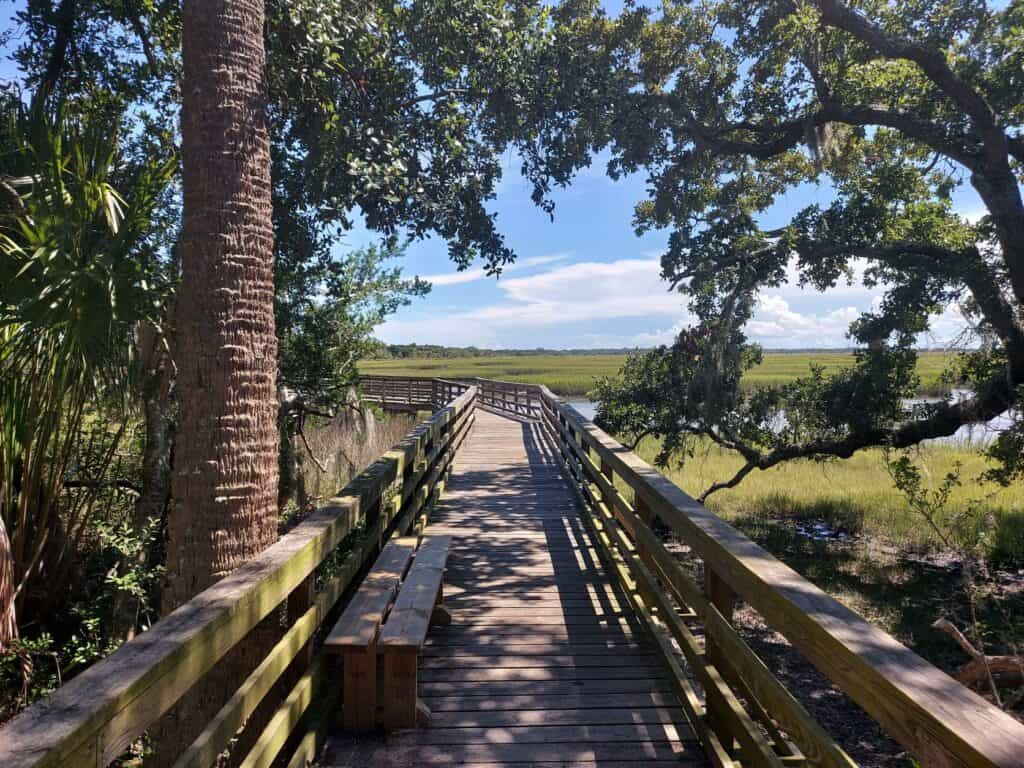The Salt Marsh and South Georgia’s Fall “Foliage”

In Southeast Georgia, our foliage does not mark a change in seasons as it does for our northern neighbors. However, one aspect of our landscape does herald fall: the salt marshes, which transition from neon-green in summer to a rich gold come autumn. As we admire this phenomenon, let us also contemplate how vital to the environment and how well-preserved our salt marshes are.
While salt marshes stretch along the entire East Coast from Florida to Maine, in Georgia the marshes cover an especially large area: the state’s meagre 100 miles of coastline contain almost 400,000 acres of salt marsh, about one-third of the Eastern seaboard’s total salt marsh area. The state’s high tidal range (difference between high and low tide) and low elevation contribute to this abundance of marshes.
Salt marshes play an important role in the ecosystem by filtering water; absorbing waves, which prevents erosion; and limiting flooding. The marshes are also vital to wildlife, tourism, and fishermen, as they serve as a nursery for fish, shrimp, and crabs. In fact, the East Coast marsh system nourishes an estimated seventy percent of the commercially important fish and shellfish we consume.
Few animals actually live in the marsh, as most are visitors looking for food or shelter. Many of these creatures, such as crabs and shrimp, enter the marsh as plankton and leave as adults. However, other organisms, such as periwinkle snails and oysters, enter to stay.

In the low marsh, which is flooded with salt water six to eight hours per day, only one kind of plant has adapted to survive: Spartina alternaflora, or smooth cordgrass, which can grow up to ten feet. As this grass absorbs water through its roots, a membrane filters out most of the salt. Extra salt is then excreted through special pores. Sometimes you may see these salt crystals on the stems and leaves of this grass.
Salt marshes are one of the most productive ecosystems in the world. One acre of salt marsh can produce between five and ten tons of organic matter, while the most fertile Iowa farm produces only half that. This fertility is due to bacteria’s decomposing dead matter and turning it into nutrients for plants and planktonic creatures. The marsh mud it produces, historically called “fluff,” was applied to local farmland, most notably on Cumberland Island, from Robert Stafford’s vast mid-1800s plantations to the Carnegies’ early-twentieth-century kitchen gardens, creating incredibly fertile soil.

Over one-quarter of Cumberland Island is comprised of salt marsh. One of my favorite views is from the Greene-Miller Cemetery overlooking Beach Creek, which winds its way through the island’s southernmost marshes. Tidal creeks such as this one are the lifeblood of marshes, as they bring in nutrients, oxygen, and water and carry away wastes. During the spring and autumn, high tides remove the marsh’s dead grass stalks and make way for new growth. These dead grasses form giant mats which float out the creeks and are deposited on the beach where, in a remarkable example of “recycling,” they trap sand and form the basis of new or expanded sand dunes to help stabilize the beach.
We can thank the Georgia General Assembly for safeguarding our marshes. In 1968, the Kerr-McGee Corporation proposed phosphate mining on 70,000 acres of marsh near Little Tybee Island, but public outcry ended their efforts. To protect Georgia’s marshes from future threats, state representative Reid Harris sponsored the Coastal Marshlands Protection Act. Signed into law in 1970, it limits both commercial and governmental development of the marshlands. A 2016 study revealed that approximately 92% of Georgia’s shoreline is dominated or fronted by salt marsh, a coastal conservation achievement which few – if any – states can claim and a vindication of this act’s efforts.
Our area possesses an abundance of quality seafood establishments, from Seagle’s and Locals Dockside in St. Marys to Ship 2 Shore in Kingsland. The next time you patronize one of them, take a moment to appreciate that our pristine and protected salt marshes most likely sheltered your freshly-caught meal.
Interested in learning more about Cumberland Island’s marshes and history? Come on a tour with us! Find out more here.



